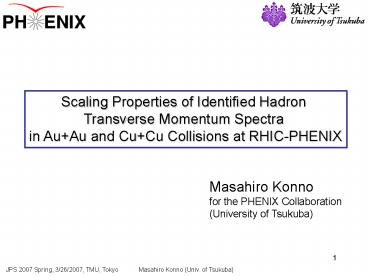Scaling Properties of Identified Hadron PowerPoint PPT Presentation
Title: Scaling Properties of Identified Hadron
1
Scaling Properties of Identified Hadron
Transverse Momentum Spectra in AuAu and CuCu
Collisions at RHIC-PHENIX
Masahiro Konno for the PHENIX Collaboration
(University of Tsukuba)
2
Hadron production in heavy ion collisions at RHIC
- - Hadron production mechanisms
- Thermal emission
- Quark recombination
- Jet fragmentation
- Bulk properties of the system
- Thermalization
- Collective flow
- Freeze-out (Chemical, Kinetic)
- High-pT phenomena in the medium
- Jet quenching(Energy loss)
- Particle correlation of jets
Soft
Space-time evolution of a heavy ion collision
Hard
- Single particle spectra and particle ratios
provide the most basic observables to
investigate the mechanisms of hadron production. - - Particle Identification (PID) over wide pT
range is also crucial.
3
Hadron production at intermediate pT
- Baryon/meson difference at intermediate pT (25
GeV/c) - Baryon enhancement in particle ratios
- Splitting of v2 strength into baryon/meson
groups - - Now explained in quark recombination picture
- - A transition from soft to hard production at
intermediate pT
p/?
What is the next?
Purposes
- Relative contributions of
- hadron production mechanisms (soft/hard)
- Scaling properties of identified hadron
- pT spectra in different collision systems.
nucl-ex/0608033
- Systematic scan over different collision
- systems (colliding species, beam energies)
- with available data obtained at PHENIX.
v2
PHENIX preliminary
(AuAu, CuCu at vsNN 62.4, 200 GeV)
(mT-m)
4
PHENIX Detector
EM Calorimeter (PID)
TOF (PID)
- - Central Arm Detectors
- Centrality and Reaction Plane
- determined on an E-by-E basis.
- PID (particle identification) is
- a powerful tool to study hadron
- production.
Aerogel Cherenkov (PID)
Aerogel Cherenkov (ACC)
Time of Flight (TOF)
Drift Chamber (momentum meas.)
p
K
Tracking detectors (PC1,PC2,PC3)
p
Veto for proton ID
5
Blast-wave Model Fit
- - Blast-wave model is a hydrodynamic-inspired
model. - - Extracting kinetic freeze-out properties with
BW model. - Simultaneous fit to pT spectra (?/K/p) for each
centrality class.
Ref PRC48(1993)2462
?2 map
( Resonance decay feed-down correction not
applied. Instead, tighter pT fitting range
used. ? 0.6-1.2 GeV/c K 0.4-1.4 GeV/c,
p/pbar 0.6-1.7 GeV/c)
Spectra for heavier particles has a convex shape
due to radial flow.
6
Blast-wave Model Fit - Tfo vs. Npart
Tfo 120 MeV
- Npart scaling of Tfo between AuAu and CuCu -
Almost same Tfo at vsNN 62.4, 200 GeV
7
Blast-wave Model Fit - lt?Tgt vs. Npart
lt?Tgt 0.5
- Npart scaling of lt?Tgt between AuAu and CuCu -
Almost same lt?Tgt at vsNN 62.4, 200 GeV
8
ltpTgt vs. Npart
- ltpTgt ?ltKltp (mass dependence) - Consistent with
radial flow picture
- Npart scaling of ltpTgt between AuAu and CuCu -
Almost same ltpTgt at vsNN 62.4, 200 GeV
9
Estimation of p/? at intermediate pT
- Extrapolate low-pT Blast-wave fit results
- to intermediate pT in order to estimate p/?
ratio.
No weak decay feed-down correction applied.
(hydro p)/(hydro ?)
(hydro p)/(real ?)
- Hydrodynamic contribution for protons is one
- of the explanations of baryon enhancement.
- - Other contribution is also needed
Recombination, Jet fragmentation
10
Baryon enhancement - p/? vs. Npart
AuAu vs. CuCu at 62.4 GeV
AuAu vs. CuCu at 200 GeV
- Npart scaling of p/? between AuAu and CuCu at
same vsNN
11
Baryon enhancement - p/? vs. dET/dy
- No Npart scaling of p/? (pbar/?) in AuAu
between 62.4 and 200 GeV. - dET/dy scaling of pbar/? seen. gt Proton
production (at this pT range) - at 62.4 GeV is partly from baryon transport,
not only pair production. - Nuclear stopping is still large at 62.4 GeV.
12
Statistical Model Fit - ?q vs. Npart
- Npart scaling of ?q between AuAu and CuCu -
Larger ?q at vsNN 62.4 GeV than that at 200 GeV
13
Summary
- Scaling properties of PID pT spectra tested
- with AuAu and CuCu data at vsNN 62.4/200
GeV. - Bulk properties (dN/dy, ltpTgt, kinetic and
chemical freeze-out - properties) are scaled with Npart (volume) at
same vsNN. - p(pbar)/? ratios
- (1) Npart scaling between AuAu and CuCu at
same sqrt(sNN) - (2) dET/dy scaling between 62.4 and 200 GeV in
AuAu - (3) pbar/? is a good indicator of baryon
enhancement - MRPC-type TOF counter (?TOF100ps) was
- installed behind the Aerogel for high-pT PID
- upgrade. Run-7 has just started for 200 GeV
- AuAu. Higher-pT physics can be reached.
On-going
14
Backup
15
Statistical Model Fit
- Extracting chemical freeze-out properties with
statistical model fit. - Fitting particle ratios of dN/dy (?/K/p) at y0.
- Assuming chemical equilibrium of light quarks
(u,d,s), ?s1. - Partial feed-down correction taken into account.
Refs Phys. Rev. C71 054901, 2005
nucl-th/0405068 NPA698(2002)306C
- - Tch, ?q relatively stable
- ?s, ?s not determined with this set of ratios
(?/K/p). Strangeness info is short.
vsNN 62.4 GeV
16
Statistical Model Fit - Tch vs. Npart
If ?s is free, Tch 155 /- 7 MeV
- Npart scaling of Tch between AuAu and CuCu -
Almost same Tch at vsNN 62.4, 200 GeV

